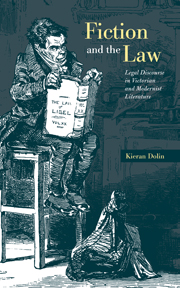Book contents
- Frontmatter
- Contents
- Acknowledgments
- 1 Narrative forms and normative worlds
- 2 The modern Western nomos
- 3 True testimony and the foundation of nomos – The Heart of Midlothian
- 4 Reformist critique in the mid-Victorian “legal novel” – Bleak House
- 5 Representation, inheritance and anti-reformism in the “legal novel” – Orley Farm
- 6 Power, chance and the rule of law – Billy Budd, Sailor
- 7 From sympathetic criminal to imperial law-giver – Lord Jim
- 8 Freedom, uncertainty and diversity – the critique of imperialist law in A Passage to India
- 9 Settling out of court
- Notes
- Index
1 - Narrative forms and normative worlds
Published online by Cambridge University Press: 18 December 2009
- Frontmatter
- Contents
- Acknowledgments
- 1 Narrative forms and normative worlds
- 2 The modern Western nomos
- 3 True testimony and the foundation of nomos – The Heart of Midlothian
- 4 Reformist critique in the mid-Victorian “legal novel” – Bleak House
- 5 Representation, inheritance and anti-reformism in the “legal novel” – Orley Farm
- 6 Power, chance and the rule of law – Billy Budd, Sailor
- 7 From sympathetic criminal to imperial law-giver – Lord Jim
- 8 Freedom, uncertainty and diversity – the critique of imperialist law in A Passage to India
- 9 Settling out of court
- Notes
- Index
Summary
Wilkie Collins's The Woman in White relates, at least according to its Preamble, a story of events that “might have claimed their share of the public attention in a Court of Justice,” but which “is left to be told for the first time in this place.” The pages of the novel are constructed as an alternative forum for an inquiry into a crime and a proclamation of right that cannot be pursued through the courts. The novel represents itself as an intervention in the public sphere, more particularly as a supplement to the law, going where it cannot go, but performing a similar function. Justice is the story's end, in both senses of that word; and it is a justice that restores the heroine to her rightful position in society, a justice that fulfils the law. Thus, while the Preamble acknowledges the limitations of the law, it also invokes the standards of legal proof in order to tell, and indeed to validate, its story:
the story here presented will be told by more than one pen, as the story of an offence against the laws is told in Court by more than one witness – with the same object, in both cases, to present the truth always in its most direct and most intelligible aspect; and to trace the course of one complete series of events, by making the persons who have been most closely connected with them, at each successive stage, relate their own experience word for word.
- Type
- Chapter
- Information
- Fiction and the LawLegal Discourse in Victorian and Modernist Literature, pp. 1 - 20Publisher: Cambridge University PressPrint publication year: 1999
- 1
- Cited by



